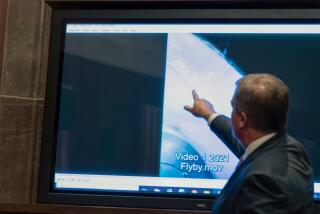NASA Says It Considered CIA Help
- Share via
HOUSTON — Senior NASA officials discussed whether to ask the Central Intelligence Agency to use spy satellites to photograph the Columbia while it was in orbit, but they decided it would not prove useful, Lambert Austin, a space shuttle official at the Johnson Space Center, said Wednesday.
Austin said engineers had held a series of discussions about using CIA photographic satellites to determine whether the shuttle had been crippled during its launch by foam debris falling off the external fuel tank. In the end, they were concerned about both the technical feasibility of the request and the usefulness of any images the agency would obtain, Austin said.
The space agency had previously disclosed that it considered and then rejected asking the Defense Department to use its powerful ground-based telescopes in New Mexico to photograph the space shuttle.
Space shuttle program manager Ron Dittemore said last month that the agency had requested and received such photographs in prior missions -- and that they did not provide enough detail to determine whether the shuttle was damaged. In one instance, shuttle engineers were concerned about the loss of a piece of shuttle structure that ultimately did not affect the safety of the mission.
But Dittemore had not previously disclosed discussions NASA held about seeking intelligence agency assistance to evaluate damage. Throughout Columbia’s final flight, engineers across the nation were evaluating whether the foam debris seen falling off the shuttle’s external tank at about 80 seconds after its Jan. 16 liftoff could have seriously damaged the orbiter.
Since the Feb. 1 accident, a number of top space experts said they were baffled by NASA’s decision to not use every asset available to assess the problem. In addition to the decision not to use the spy satellites and the military telescopes, NASA rejected performing computer simulations that could predict how damage could affect the orbiter’s landing ability.
Boeing Co. engineers produced three reports to assess whether the foam could have compromised the shuttle’s thermal protection system. In the second report, the Boeing engineers advised NASA that they did not believe the orbiter was damaged and that it would have a “safe return.”
After discussing the use of spy satellites, NASA engineers decided against recommending that Dittemore ask the CIA to focus its powerful photographic reconnaissance satellites on the Columbia. Such photographs presumably would have provided much higher-definition images than ground-based telescopes, which must shoot through the Earth’s atmosphere.
“I was involved in a series of telephone calls that explored the feasibility of getting a photographic assessment from space,” Austin said in an interview Wednesday.
“But there was never a request for a photo to be taken from space. We never recommended to Dittemore that the request be made.”
Austin declined to elaborate on why the photographs might not have been feasible. Such a photograph would have required the spy satellite, moving in a north-to-south orbit at more than 17,000 mph, to find and then track the orbiter, which was moving in a west-to-east orbit at more than 17,000 mph.
Typically, when the intelligence community wants to obtain photographs of other nations’ satellites, they do so from powerful ground-based military telescopes.
Air Force Lt. Col. Woody Woodyard, a spokesman for the Columbia Accident Investigation Board, said Wednesday that he was not aware of the issue of using CIA photographs.
More to Read
Sign up for Essential California
The most important California stories and recommendations in your inbox every morning.
You may occasionally receive promotional content from the Los Angeles Times.














